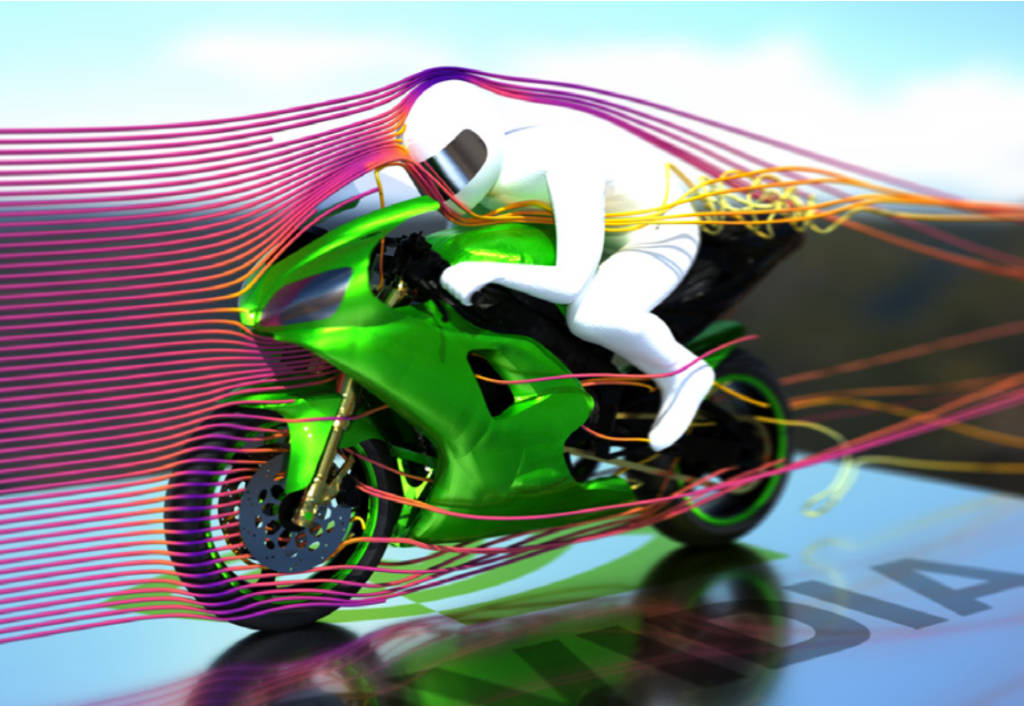Exploratory Group - Analytic Rendering Overview
Main page content

Khronos has formed an Exploratory Group to discuss the standardization of an Analytic Rendering API for data visualization. All interested parties are invited to participate, with no cost or IP obligations, to share perspectives, requirements and use cases to help determine whether there is an industry need for such an API and to help set the direction for any standardization activities.
What is Analytic Rendering?
Analytic Rendering is image generation performed primarily to gain and communicate insights into complex data sets. Scientific visualization is the primary application domain using Analytic Rendering today, followed by the emerging data analytics space.
 VMD ray traced visualization of swine flu A/H1N1 neuraminidase bound to Tamiflu – VMD, U. Illinois
VMD ray traced visualization of swine flu A/H1N1 neuraminidase bound to Tamiflu – VMD, U. Illinois
 Pathtraced visualization of OpenFOAM motorbike – NVIDIA
Pathtraced visualization of OpenFOAM motorbike – NVIDIA
Why is a New Analytic Rendering API Needed?
Recent advances in rendering technology, especially the introduction of real-time ray tracing, has great promise to significantly impact data visualization by providing physically accurate imagery and visual cues for an intuitive understanding of complex data. However, using these graphical techniques can come at the cost of increased application development cost and complexity. Graphics APIs such as Vulkan, and its upcoming ray tracing extension, provide powerful rendering hardware abstractions, but may be too low-level and development-heavy for many visualization applications to utilize effectively.
Consequently, several hardware vendors have developed higher-level rendering APIs, such as Intel’s OSPRay and NVIDIA’s VisRTX, but this leads to ecosystem fragmentation as visualization applications need to be ported to multiple, incompatible platforms.
An open, higher-level Analytic Rendering API standard could significantly reduce software development costs while making advanced rendering techniques more accessible and widely used by visualization applications for which rendering is just a necessary technique to be utilized, while providing portability to multiple platforms that support the common API.
Goals for an Analytic Rendering API Standard
 Ray traced visualization courtesy of Oak Ridge Leadership Computing Facility
Ray traced visualization courtesy of Oak Ridge Leadership Computing FacilityThe goal of this initiative would be to define a high-level API to simplify the development of visualization applications while leveraging the full potential of modern rendering capabilities. The Analytic Rendering Exploratory Group is proposing to define a concise, high-level API as a contract between visualization domain experts and rendering technologists, enabling a “win-win” by simplifying implementation and deployment for both groups. Some key goals include:
- Create an open, royalty-free API that is platform independent – enabling visualization applications to portably access diverse rendering backends
- Provide visualization applications access to the full range of modern rendering capabilities and engines, including – but not restricted to – the latest ray tracing techniques
- Free visualization domain experts from the necessity of dealing with non-trivial rendering details and multiple incompatible backend rendering APIs
- Enable graphics experts developing rendering backends to avoid the need to implement domain-specific functionality and optimizations through supporting a well-designed, cross-platform API standard – and hence making their backend renderers accessible to a wider diversity of disciplines and audiences.
Analytic Rendering API Design
Rather than specifying the details of the rendering process, the Analytic Rendering API would enable a visualization application to simply describe the relationship between objects in a scene to be rendered and leave the details of the rendering process to a backend renderer. Unlike more general scene graph APIs, the proposed initiative would focus specifically on the needs of the visualization domain - and as with any successful interoperability standard, the proposal would enable and encourage a diverse range of competitive API implementations.
Get Involved!
To gather industry input, the Exploratory Group is open to any company without cost or IP licensing obligations. Those interested in learning more and joining the Exploratory Group are invited to email us.
If there is industry support, Khronos will form a Working Group to enable any interested company to join Khronos and participate under its proven multi-company governance process. If an organization is interested in becoming a Khronos member, please visit our Member page or contact Membership Services.
Initial Exploratory Group Participants

Industry Quotes
“The Analytic Rendering API, not only will contribute to application portability of scientific visualization tools, but also will reduce the burden of developing, deploying, and maintaining visualization codes across heterogeneous HPC architectures.”
“An open, high-level Analytic Rendering API could be a huge productivity booster for us—such an API would likely reduce our development and maintenance costs quite significantly, simply by providing instantaneous portability across multiple hardware platforms.”
Sidebar Links and other content
Related News
- Presidents of EMVA and The Khronos Group Discuss Embedded Camera Exploratory Group
- Shaping the Scene for Vision Standardization
- The IMVE Interview: Khronos and EMVA Discuss New Embedded Camera Exploratory Group
- Embedded Camera API Exploratory Group Receives Positive Industry Response - 40+ Companies Have Joined the Group
- OLCF staff involved in Khronos effort to create new visualization standard


